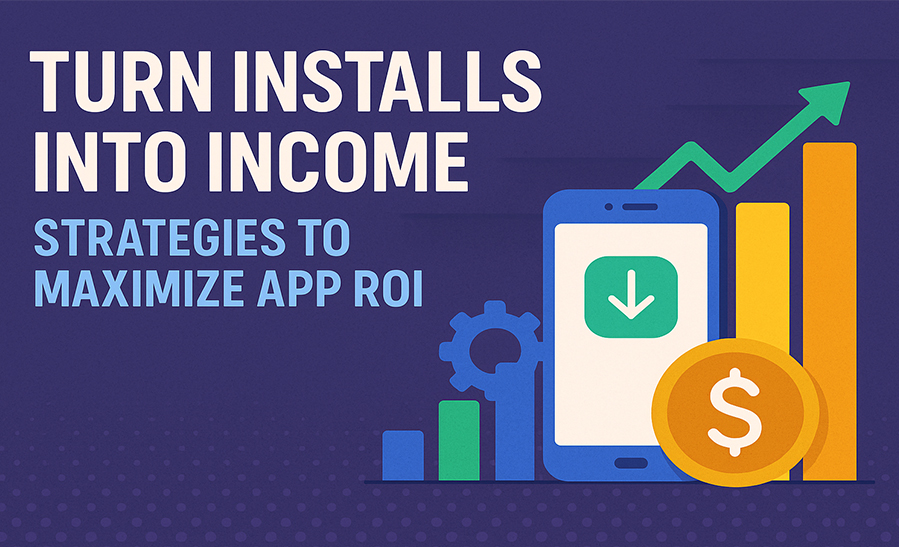Turn Installs into Income: Strategies to Maximize App ROI
In today’s hyper-competitive mobile landscape, just getting your app installed isn't enough. With over 5 million apps across Android and iOS platforms, the real challenge begins after the download. How do you turn those installs into actual income? That’s where maximizing your app’s Return on Investment (ROI) comes into play.
At Substance Communication, we believe that app success is not just about visibility it's about sustainability. Whether you’re a startup, indie developer, or a full-fledged brand, understanding the right metrics and implementing smart strategies is key to converting downloads into revenue. Here’s a detailed, practical guide on how to do just that.
Step 1: Define What ROI Means for Your App
Before diving into metrics and strategies, it’s important to define what ROI means for your business. Is it purely revenue? Is it user engagement, customer lifetime value (CLTV), or retention rates?
Formula-wise, App ROI = (Gains from Investment Cost of Investment) / Cost of Investment
But beyond math, ROI should align with your business goals. For example:
• Gaming apps may focus on in-app purchases and session duration?
• E-commerce apps will track conversions and repeat transactions
• Utility apps might prioritize subscription revenue and long-term usage
Once your ROI goal is clear, everything else becomes measurable.
Step 2: Track the Right Metrics
To maximize ROI, you need to know what’s working. That starts with tracking key performance indicators (KPIs). Here are some essential ones:
• Customer Acquisition Cost (CAC): How much are you spending per user acquired?
• Lifetime Value (LTV): The average revenue generated by a user over time.
• Retention Rate: What percentage of users return after Day 1, 7, or 30?
• Churn Rate: How quickly are users uninstalling or becoming inactive?
• Conversion Rate: How many free users convert to paid users?
• ARPU (Average Revenue Per User): Revenue generated divided by the number of users.
Pro tip: Tools like Firebase, Adjust, Appsflyer, and Mixpanel can help you track all of the above.
Step 3: Optimize User Onboarding
First impressions are everything. If a user doesn’t understand how to use your app in the first few minutes, they’ll likely never come back.
This makes the on boarding experience critical to ROI.
Here’s how to improve it:
• Keep it simple and visual (use walkthroughs or tooltips)
• Minimize the number of steps to sign-up or start
• Personalize onboarding based on user behavior or interests
• Offer a guided tour, especially if your app is complex
Remember, every drop-off during onboarding is money lost.
Step 4: Monetization Choose the Right Model
Monetization isn’t one size fits all. The right strategy depends on your app type, audience, and usage pattern. Common models include:
1. In-App Advertising
Best for free apps with high engagement. Use native or rewarded ads to keep UX smooth.
2. Freemium + Subscriptions
Offer basic features for free and charge for premium ones. Ideal for fitness, productivity, or content-based apps.
3. In-App Purchases (IAP)
Let users buy virtual goods, features, or upgrades. Effective in gaming and entertainment apps.
4. Pay-to-Download
Still relevant for niche tools or apps with unique value propositions.
5. E-commerce or Service Commission
Apps like delivery, booking, or shopping make revenue from sales or service charges.
Choose a model that aligns with your audience's willingness to pay.
Step 5: Retention Over Acquisition
It’s tempting to keep pumping budget into user acquisition. But if those users uninstall within days, your CAC will go through the roof.
Instead, focus on retention, because:
"A 5% increase in customer retention can increase profits by 25% to 95%." Bain & Company
Retention strategies to try:
• Push notifications (but avoid overuse)
• Loyalty programs
• Regular feature updates
• Personalization using AI and data
• Email re-engagement campaigns
Users who stick around longer are more likely to convert and spend.
Step 6: A/B Test Everything
From your app icon to the call-to-action (CTA) in a push notification, test everything. What seems like a small design tweak might significantly boost conversions.
Things to A/B test:
• On boarding flows
• Ad placement and frequency
• Pricing tiers
• UI/UX elements
• Store listing (title, screenshots, description)
Use analytics tools to measure the impact and optimize accordingly. Iteration is the name of the game.
Step 7: Leverage ASO and Reviews
App Store Optimization (ASO) is your free ticket to more installs if done right. But it also affects ROI by increasing organic installs, which have a lower CAC.
Key ASO factors:
• Keyword-rich title and description
• High-quality screenshots and preview video
• Regular updates and bug fixes
• Positive user reviews and ratings
Encourage satisfied users to leave reviews and respond to all feedback, good or bad.
Final Thoughts
Turning installs into income is both a science and an art. It requires a mix of solid metrics, user psychology, and constant experimentation. With the right strategies in place from onboarding and monetization to retention and optimization your app can become more than just a download. It can become a profitable digital asset.
At Substance Communication, we help brands and startups scale their mobile presence with growth-focused strategies that deliver real ROI. Whether you're launching your first app or optimizing your tenth, our team brings the insights and execution power to help you win.
Want to grow your app's revenue?
Let Substance Communication help you turn installs into income starting today.

